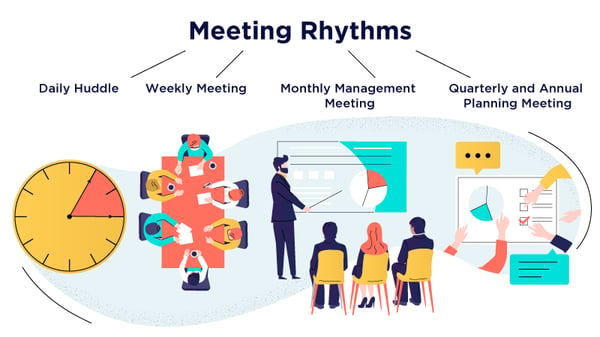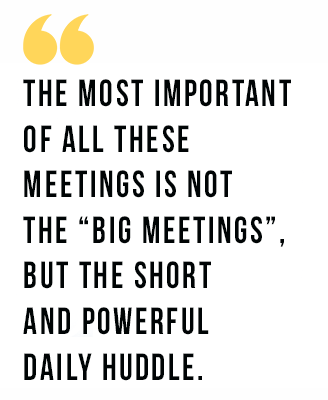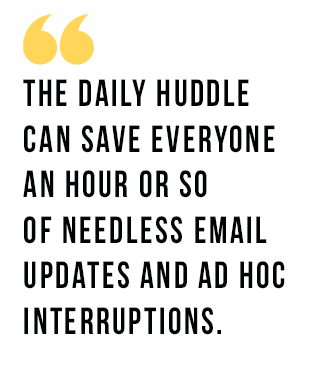Why the 15-Minute Daily Huddle is Critical to Scale Up Your Business

In my book, Scaling Up, I cover four different types of meetings every organization should regularly have to address communication challenges and make important decisions for scaling up the organization.
Before We Start – Download the Free Rockefeller Habits Checklist!
To maximize the value of this article, download the Rockefeller Habits Checklist now. As you read, you can follow along and assess where your company stands in implementing these proven execution habits.
📥 [Download the Rockefeller Habits Checklist Here]
By the end, you’ll have a clear framework to improve execution, enhance alignment, and scale your business with discipline.
Let’s dive in!
What are the four different types of meetings?
- The daily huddle – a 5-15 minute meeting to discuss tactical issues and provide updates.
- The weekly meeting – a 60-90 minute discussion to review progress on the quarterly priorities and address one or two main topics.
- The monthly management meeting – a half-day or full-day meeting, in which all senior, middle, and frontline managers come together to learn and collaboratively address one or two big issues.
- The quarterly and annual planning meetings – 1-3 day offsite meeting where leaders establish the next quarterly and/or annual theme.
Before we dive deeper into the daily huddle, let’s understand the importance of establishing these meetings as the most important routine your team follows.

Three Powerful Advantages to Having Regular Meetings
Meeting rhythms provide several touch points for people in the company to stay updated on important projects and goals. Setting up these four different types of meetings is crucial to scale up your organization in a healthy manner. Here's why:
- They save you time: When a communication rhythm is established, information moves through the organization accurately and quickly. This helps an organization work productively and address is
 sues in a more timely manner.
sues in a more timely manner. - They reduce hassle: It often takes longer to set up meetings than it does to hold them. Pre scheduling regular meetings act as placeholders in everyone’s calendar thus reduce hassles.
- They make it easier for you to attain goals: Regular meetings allows for important discussions to unfold around new opportunities, strategic concerns, and bottlenecks as they arise to ensure your organization stays on track to achieve its goals.
What is the Daily Huddle?
The daily huddle (or the daily stand-up or the daily scrum - whatever terminology you prefer) is a short meeting meant to occur every day so that the entire team can get informed and aligned on the work that needs to be done.
This meeting should be short - 15 minutes is the optimal length - to avoid wasting unnecessary time and ensuring that only the most important issues are brought up. It may sound like 15-minutes is too short to make any progress on, but what makes the daily huddle such a critical meeting rhythm is the time saved from this brief check up.

The Potent Power of the Daily Huddle
Daily huddles are an absolute necessity as you scale the company. Highly successful leaders includingJohn D. Rockefeller and Steve Jobs implemented the daily huddle to continuously scale their business from success to success. And is also an important habit in my 10 Rockefeller Habits checklist.

The daily huddle tracks progress and brings out sticking points that are blocking your execution. This will help you avoid minor train wrecks and quickly take advantage of unforeseen opportunities. The daily huddle can save everyone an hour or so of needless email updates and ad hoc interruptions. Finally, issues that emerge from daily huddles drive the main topics for the weekly meeting.
Today, tens of thousands of companies around the world have discovered the freedom and power that comes from implementing this simple meeting rhythm. One example is the Ritz-Carlton, which gathers about 80 people at their headquarters for a 10-minute daily huddle to receive updates from Boston to Bali. Meanwhile, all 35,000 Ritz-Carlton employees participate in some kind of daily huddle at their local hotels.
How You Can Masterfully Execute the Daily Huddle
Follow this 6-part guideline to masterfully execute the daily huddle in your organization and reap the rewards.![]() Part 1: Timing
Part 1: Timing
Choose whatever time best fits the rhythm of your business. Make sure you always start the meeting on time, whether everyone is present or not.![]() Part 2: Setting
Part 2: Setting
Meet wherever you want, but stand up or perch on stools. It’ll help keep the meeting short. Gathering in the leader’s office makes it more convenient for him or her.![]() Part 3: Who Attends
Part 3: Who Attends
The general rule is to have more people in fewer meetings, rather than fewer people in more meetings. That’s true even if only 10 to 15 participants do most of the sharing.![]() Part 4: Frequency
Part 4: Frequency
In general, frontline employees will be in only one daily huddle, and anyone in management will be in two: one with their direct reports and one with their peers and leader.![]() Part 5: Who Runs the Meeting
Part 5: Who Runs the Meeting
Pick someone who is naturally structured and to keep meetings running on time. The person running the meeting also has the important job of saying, “Please take it offline” whenever people get off on a tangent that doesn’t require everybody’s attention.![]()
Part 6: The Agenda
The agenda covers three things and you should spend no more than five minutes per item:
- What’s up?
- What are the daily metrics?
- Where are you stuck?
In the first five minutes, each attendee spends a few seconds (up to 30) sharing very specifically what’s up in the next 24 hours. These should ONLY relate to key activities, meetings, decisions, etc.
The next five minutes are then spent verbalizing the daily metrics your company monitors. Look for patterns and trends which can give you a jump on the competition and on your own challenges.
The last five minutes is the most important agenda item. Here, members of your team bring up constraints and concerns that could prevent them from having a great next 24 hours. The brutal facts need to be shared, and the leader needs to see the patterns of “stucks” to understand what underlying issues must be addressed.
Productive Tips & Things to Avoid Doing in Daily Huddles
Here are some tips to make the most out of your daily huddles as well as things to avoid.

Productive tips
- If some people will dial in regularly, put everyone on a conference call. There’s nothing worse than having a few people huddled around a speaker phone every day.
- You can use daily huddles to keep projects between companies/suppliers/customers on time and on budget.
- Team members should share a “stuck” even if they don’t think there’s anyone on the team who can help them resolve it. Verbalizing the issue is likely to spur unexpected action for help.
- Anytime somebody goes two days without reporting a constraint, you can bet there’s a bigger problem lurking. So, challenge the team member who reports, “Everything is fine!”
- Set the start of the daily huddle at an odd time, like 8:08 or 16:16. People are more likely to be on time than if you schedule the meeting on the quarter-hour or half-hour.
- It’s equally important to end on time. Use a timer for the first few weeks and end the meeting on time even if the agenda isn’t complete. Team members will learn to get to the point and move on to the next item.
- Plan 1 minute per person, meaning that an eight-person team should expect an eight-minute daily huddle.

Things to avoid:
- Don’t pile too much into the daily huddle, or it’s going to extend past the 15-minute limit and people will start to resent the meeting. Remember, the daily huddle is just one part of your meeting rhythms. Save the wider issues for meetings that can fit them.
- Don’t have one daily huddle for each internal project if many of the project teams share many of the same members. This could mean each team member could end up in three to five daily huddles, which is unworkable. The solution is to host one daily huddle involving all team members associated with the projects. Only the project leads provide updates, and then team members spend the balance of the 15 minutes self-organizing into ad hoc groups to discuss items of interest.
- Avoid checking up on whether someone did something the previous day. Team members will start feeling like they are being micromanaged. In general, looking forward is great management; looking backward is micromanagement. Avoid using videoconferencing, which adds one more level of technology complexity. The exceptions are fixed-based operations that communicate every day.
Have questions or comments about Daily Huddles? Share them below!
For a practical way to learn how to apply this concept into your current business while getting mentorship, peer-to-peer feedback, and customized support as you implement, check out my Scaling Up Master Business Course here.




